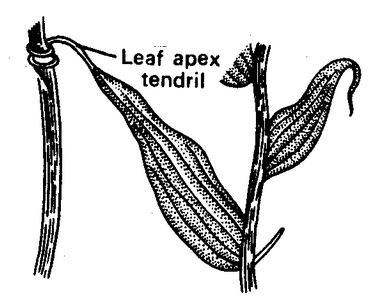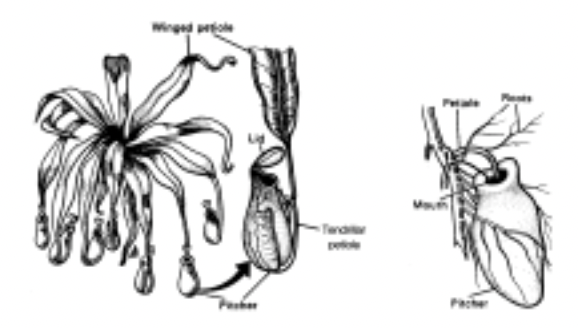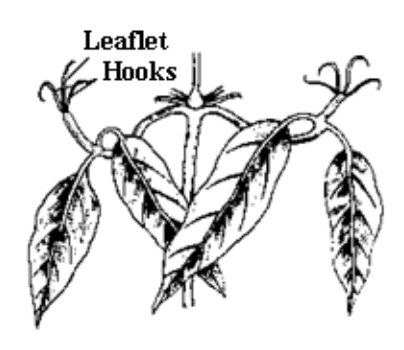The Leaf
Morphology Of Angiosperm of Class 11


Leaf tip tendrils of Stipular tendrils of Gloriosa Smilax
Fig. Modifications of leaf tendrils
|
Fig. Leaflet hooks of Bignonia |
- Scale leaves: These are thin, dry, membranous structures which protect axillary buds. When they store food materials, they become thick and fleshy (e.g., onion). Scale leaves are common on underground stems, saprophytes, parasites, Ficus, Artocarpus, Casuarina (Jhau), Tamarix (Banjhau), etc.
- Leaf hooks: In Bignonia unguis cati, three terminal leaflets are modified into sharp, pointed and curved hooks which help the plant in climbing. In Asparagus, leaves on main stem get modified into hooks.
- Phyllode: The part of leaf which is not leafy is modified into a leafy structure, is called phyllode. In Australian Acacia, petiole is modified into phyllode. In Jerusalem thorn (Parkinsonia aculeata), the secondary rachis is modified into phyllode.
- Pitcher: In pitcher plant Nepenthes the lamina of leaf is modified into a pot like structure called pitcher. The petiole is modified into tendril while the leaf apex forms the lid. Pitcher contains water and digestive juice. When insects enter the pitcher, digestive juice digests them.
- But the pitcher of Dischidia rafflesiana is non-insectivorous and without lid. Water is stored inside the pitcher and is then absorbed by adventitious roots (nest roots).
- Bladder: In some aquatic plants like bladderwort (Utricularia), the leaf is very much segmented. Some of these segments get modified into sac like structures called bladders. They have trap-door entrance which allows aquatic insects to pass in but never to come out.
- Succulent leaves : These are fleshy or swollen leaves which store water, mucilage or food materials. Mostly present in saline or xerophytic habitats e.g., Aloe, Agave, Bryophyllum, Portulaca.

Nepenthes Dischidia
Fig. Pitcher shaped leaf

Fig. Types of palmate compound leaves










